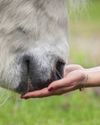The reproductive cycle – part one.

The fight for survival is the strongest instinct for the horse, and one of the factors contributing to survival is producing offspring. Reproduction is thus a strong drive for the horse. Small wonder then that your mare’s reproductive cycles may produce pretty obvious signs, and her attention when in season (also known as ‘in heat’) is not primarily focused on you. Understanding what’s going on, and the timing, can help you deal with it more effectively.
Background
A mare reaches puberty at the average age of 18 months, but it can be as early as 10 and as late as 24 months. Although a filly can conceive at an early age, like a teenager she may be too immature to handle having a foal and the pressure of being a mother. The older mare also shouldn’t be put in a situation of having a foal if she cannot handle it. Fertility begins to decline from age 15 to 21. Other factors affecting fertility is the mare’s condition – the healthier the mare, the higher her rate of conception. Genetics also play a big part, as well as characteristics and conformation.
The ultimate question about whether to breed with your mare revolves around the chance of her delivering a live, healthy foal. The mare should first be in a good state of health, as well as free from any disease or condition that could impact her fertility, conception and gestation. A mare’s gestation period is typically 11 months.
The mare’s cycle – in season
The mare’s cycle, as a normal mare being bred to a normal stallion and assuming she will conceive, is set out below (in very basic format). The goal of this cycle is to deliver a fertile egg into the reproductive tract, where it can be fertilised.
この記事は HQ magazine の July 2017 版に掲載されています。
7 日間の Magzter GOLD 無料トライアルを開始して、何千もの厳選されたプレミアム ストーリー、9,000 以上の雑誌や新聞にアクセスしてください。
すでに購読者です ? サインイン
この記事は HQ magazine の July 2017 版に掲載されています。
7 日間の Magzter GOLD 無料トライアルを開始して、何千もの厳選されたプレミアム ストーリー、9,000 以上の雑誌や新聞にアクセスしてください。
すでに購読者です? サインイン

The Science Behind Tapering
The science behind tapering

Horse Treats
The ultimate guide

Horsey Hair Care
Tips and tricks for a healthy mane and tail

Horsey Hydration- The Importance Of Water In Winter
The importance of water in winter

A Horseback Safari
Abelana Game Reserve

The Psychology Of Riding Performance
Intrinsic motivation, part 7

10 Best Life Lessons From Horses
Life lessons from our horses

Breaking New Ground
The evolution of the Callaho Online Auction

Horse Psychology 101
Part 3: The horse's cognitive abilities

Colic Part 1
An owner’s worst nightmare